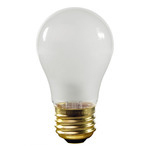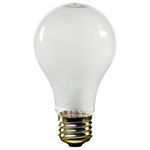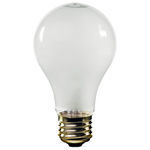Standard Light Bulbs
Are Incandescent Bulbs Dimmable?
Yes, all incandescent bulbs are dimmable and compatible with most dimmers. However, we don't recommend using incandescent bulbs with an LED dimmer. Chances are if you have an LED dimmer, you've already updated to LED bulbs as well. But if the dimmer controls more than one bulb on the circuit and is not designed to support multiple technologies, you may want to spring for a new LED bulb.
Can I Use a Higher Wattage Bulb Than Recommended on a Lamp?
If you are switching to LED bulbs, you can use a higher wattage equivalent bulb so long as the actual wattage of the bulb does not exceed the fixture's rating. For example, you can use a 100 Watt equal LED bulb to replace a 60 Watt incandescent bulb because the LED bulb only uses 15-20 Watts, well below the maximum rating of the fixture. You cannot use a 100 Watt incandescent bulb, because the bulb would draw more power than the fixture can handle. This would cause the bulb to overheat, burn out prematurely, potentially cause damage to the fixture, and become a fire hazard.
3-Way, Appliance, and Rough Service Light Bulbs
Some incandescent light bulbs are used in specialty applications such as microwaves or ovens, where you can't use LED bulbs. These appliance bulbs tend to be smaller and a lower wattage, between 15 to 60 Watts. You may also be using incandescent light bulbs for your ceiling fan, vent hoods, and other specialty applications. Ceiling fan bulbs have special reinforced filaments to withstand the vibrations. They may have a different shape from standard A-shape bulbs or have a smaller candelabra base. For medium base ceiling fans, rough service bulbs work the same way. The extra thick filament extends the life of the bulb when used in high vibration applications such as a ceiling fan or garage door opener. Rough service light bulbs may also be shatter proof, meaning the bulbs can crack, but have a protective layer to keep the bulb from shattering after impact.
Another specialty bulb is a 3-way bulb, which allows you to switch between three levels of light (low-medium-high). Unlike other incandescent bulbs, 3-way bulbs only operate at full light for each low, medium, or high setting. The light bulb uses dual filaments, turning one or both on to create adjustable lighting levels. The lowest power filament energized alone produces the lowest light level. The higher power filament energized alone produces the middle level, and both filaments energized together produce the highest wattage. For example, the light may be 30/70/100 Watts or 50/100/150 Watts depending on which setting is being used. The highest wattage is always the sum of the two lower wattages.
Incandescent Light Bulb Shapes
When you're looking to replace a household incandescent bulb, there's a good chance it's a standard shaped bulb. These light bulbs are found in table lamps, floor lamps, vanity lighting, wall sconces, pendant lighting, and porch lights. The most common household size is an A19, followed by the slightly larger A21. The number following A is the diameter of the bulb in eighths of an inch, meaning a typical A19 bulb is 2.375 (19/8) inches in diameter and an A21 bulb is 2.625 (21/8) inches in diameter. The A21 light bulb is also taller, usually a little less than an inch. Although the height difference may not matter in most applications, it can be enough to keep an A21 from being able to fit into enclosed or shallow fixtures when replacing an A19. You can also find A-shaped bulbs in A15 and A23 sizes. The smaller A15 bulbs are lower wattage and the A23 are higher wattage.
Once you get into 200 Watt bulbs and higher, the shape changes. The neck and bulb are quite a bit longer, and the A is replaced by a PS. Sizes include PS25 through PS40. PS bulbs may have a medium E26 base or need a larger socket to fit the mogul E39 base. These incandescent bulbs can produce over 23,000 Lumens and are only found in commercial or industrial applications. These are not meant for residential use.








